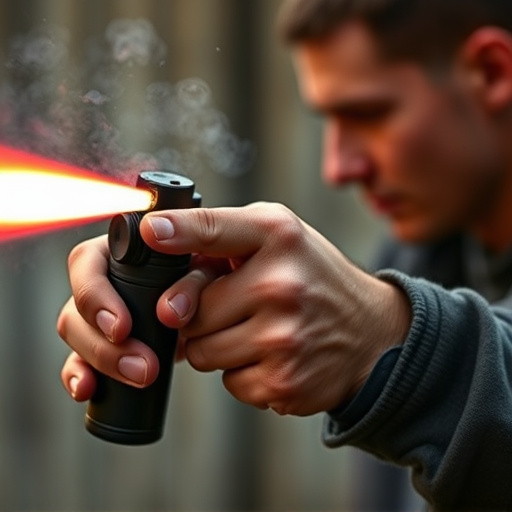Non-lethal pepper spray defense, using oleoresin capsicum (OC) spray, offers individuals a powerful yet safe self-defense tool against threats. With capsaicin as its active ingredient, it causes temporary blindness, coughing, and pain, allowing users to escape or subdue attackers. Key factors in choosing personal protection include spray effectiveness, ease of use, durability, and legal considerations. Proper training and technique, along with understanding range, activation, and targeting, maximize impact. Regional laws regulate deployment, emphasizing responsible use and threat assessment, while regular training fosters safety within communities.
In today’s unpredictable world, personal protection is paramount. One effective tool gaining popularity is non-lethal pepper spray, a powerful defense mechanism for individuals seeking safety. This article delves into the intricacies of this chemical irritant, covering its understanding, selection criteria, application techniques, and legal aspects. We explore how to maximize its effectiveness while adhering to responsible use guidelines. Equip yourself with knowledge on non-lethal pepper spray defense and make informed decisions for your security.
- Understanding Non-Lethal Pepper Spray: The Basics
- Selection Criteria for Effective Personal Protection Devices
- Application Techniques and Training for Optimal Effectiveness
- Legal Considerations and Responsible Use of Chemical Irritants
Understanding Non-Lethal Pepper Spray: The Basics
Non-lethal pepper spray, also known as oleoresin capsicum (OC) spray, is a powerful defensive tool designed to incapacitate and deter potential threats without causing permanent harm. This type of spray is commonly used by law enforcement, security personnel, and individuals seeking protection against aggressive dogs, assailants, or other dangerous situations. The active ingredient in pepper spray is capsaicin, the same chemical that gives chili peppers their heat. When sprayed, capsaicin irritates the eyes, nose, throat, and skin, leading to temporary blindness, coughing, difficulty breathing, and intense pain. This reaction allows the user to escape or subdue their attacker, providing a crucial window of safety.
The effectiveness of non-lethal pepper spray lies in its ability to stop an attack quickly and safely. Unlike lethal force, it doesn’t carry the risk of permanent injury or death, making it a preferred option for self-defense in many situations. Moreover, pepper spray is easy to use, non-persistent (meaning it wears off relatively quickly), and legal in many jurisdictions, making it an attractive defense mechanism for individuals seeking to protect themselves without resorting to deadly force.
Selection Criteria for Effective Personal Protection Devices
When selecting personal protection devices, especially those employing non-lethal pepper spray as a defense mechanism, several critical factors come into play. The primary consideration is the device’s effectiveness in neutralizing attackers without causing severe harm. This involves evaluating the concentration and type of capsaicin (the active ingredient in pepper spray) to ensure it can incapacitate an assailant temporarily.
Additionally, the ease of use and reliability in stressful situations are paramount. Devices should have intuitive triggers or mechanisms that allow users to deploy the spray promptly, ensuring they can react quickly during a threatening encounter. Durability and weather resistance are also essential, as personal protection devices may need to be used in diverse environments, from urban streets to outdoor settings.
Application Techniques and Training for Optimal Effectiveness
For optimal effectiveness in self-defense scenarios, proper application techniques and training are paramount when utilizing non-lethal pepper spray. It’s crucial to understand the device’s range, activation mechanisms, and spray patterns. Practice aiming at various distances and angles, focusing on targeting eyes and face areas for maximum impact. Training sessions should also incorporate scenario-based drills that simulate real-world situations, allowing users to develop muscle memory for quick and accurate deployment.
Regular practice with a trained instructor ensures individuals master the proper technique – holding the can upright, activating the spray, and angling it correctly. This hands-on experience is invaluable, as it overcomes any initial fear or hesitation that could impede response time during an actual emergency.
Legal Considerations and Responsible Use of Chemical Irritants
In many jurisdictions, the use of chemical irritants for personal protection is governed by strict legal frameworks designed to balance individual rights and public safety. Non-lethal pepper spray defense, for instance, is a widely used tool that falls under these regulations. It’s crucial for users to understand and comply with local laws, as unauthorized possession or misuse can lead to severe consequences. Law enforcement agencies often have specific guidelines on when and how such irritants can be deployed, ensuring their responsible use.
The ethical deployment of chemical irritants requires a conscious effort to minimize harm and respect the rights of others. Responsible use involves assessing threats accurately, using only as much force as necessary, and avoiding indiscriminate spraying. Regular training and awareness programs are essential for individuals carrying non-lethal pepper spray to ensure they make informed decisions in high-stress situations. This balanced approach facilitates personal protection while promoting a culture of safety and respect within communities.
Non-lethal pepper spray, a powerful tool in personal protection devices, offers individuals a means of self-defense while emphasizing responsible use. As highlighted in this article, understanding the basics, selecting the right product, and proper training are essential for optimal effectiveness. Legal considerations play a crucial role in navigating the use of chemical irritants, ensuring their application aligns with local regulations. By equipping ourselves with knowledge and adhering to guidelines, we can harness the benefits of non-lethal pepper spray defense while promoting safety and accountability.
